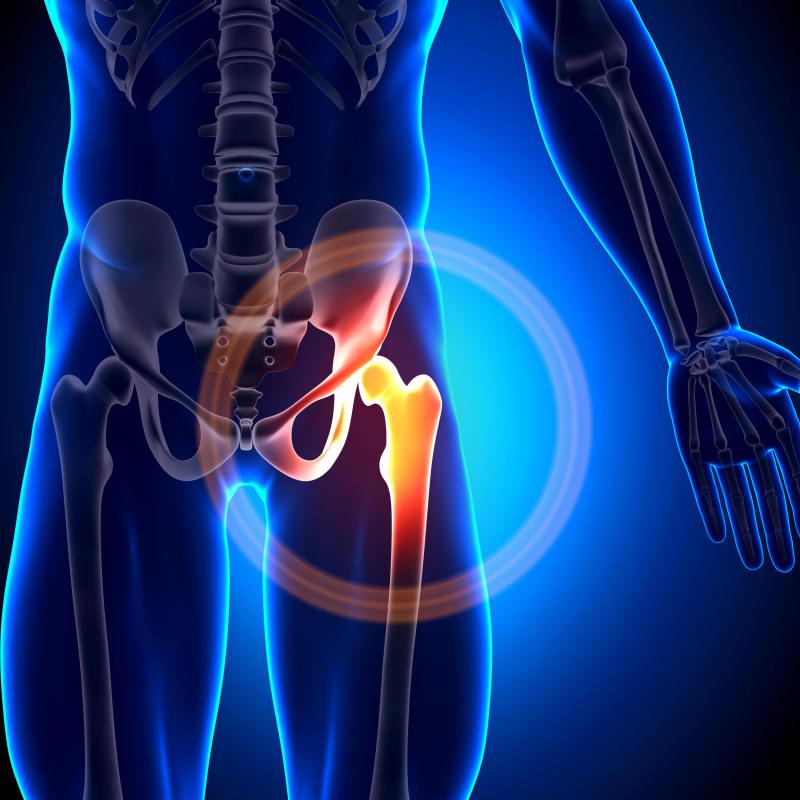At TheHealthBoard, we're committed to delivering accurate, trustworthy information. Our expert-authored content is rigorously fact-checked and sourced from credible authorities. Discover how we uphold the highest standards in providing you with reliable knowledge.
What Should I Expect from a Hip MRI?
Hip pain may require a test called magnetic resonance imaging (MRI), to diagnose the underlying cause of the discomfort. During a hip MRI, the patient is asked to lie very still in a tube-like structure as the test is performed. A loud, clanging noise may be heard throughout the test, as the magnets move to provide accurate imaging. The test is painless and completely non-invasive and usually takes between 30 and 60 minutes.
An MRI machine is composed of three parts. The primary magnet is very large and is used to create the magnetic field necessary for the technology to work. Gradient magnets are smaller and allow the machine to focus on a specific body part. The coil is the part of the machine located nearest to the part of the body being tested, in this case the hip. The parts work together to send radio waves through the body, creating a detailed image of the inside of the hip.

Before an MRI, the patient will be asked to remove all metal jewelry and clothing. Any metal within the body must be reported to the technician performing the test as some metals are incompatible with this exam. Patients with pacemakers or other internal devices may not undergo hip MRI. Watches, credit cards, and other items may be negatively affected by the magnets and should not even be taken into the examination room.

Patients will usually be asked to change into a hospital gown prior to the procedure. A lab technician will assist the patient into an appropriate position on the examination table. Depending on the imaging lab, the MRI machine may be similar to a tunnel or it may have two or more open sides.
As the MRI begins, the patient must remain very still so that the resulting images are clear. When the magnets are working, the machine can be very loud. The sound is similar to a loud knocking or banging. Periodically during the test, the knocking may stop and resume. The technician administering the exam should be available to the patient via microphone during the procedure.

Sometimes patients have difficulty remaining still for the 30 to 60 minutes required to complete the hip MRI. If this is the case, a doctor may provide medication to take prior to the test to assist in relaxation. If this is a concern, the doctor should be informed before scheduling the hip MRI so that the medication may be prescribed.
A hip MRI is a painless procedure. It assists doctors in diagnosing the causes of hip pain so that appropriate treatment may be provided. There is no special preparation for the procedure, and patients may return to normal activities immediately following the test.
AS FEATURED ON:
AS FEATURED ON:














Discussion Comments
The article suggests that patients may avoid claustrophobia during an MRI, by taking medication before the test. The medicine is meant to help them relax. This is a good idea, but patients who wish to avoid taking medication can try other alternatives. For instance, listening to music might be helpful. Also, bringing a companion with for moral support and to help you through the process, is another way to sidestep claustrophobia. This coupled with an open machine design will almost guarantee avoidance of the symptoms associated with claustrophobia.
Yes, the MRI machine that has the traditional tunnel design is very close and patients who are claustrophobic, or even those who have never experienced claustrophobia before, could feel the effects during the MRI test. But, the good news is, there are several different types of machines and choosing the right one will reduce the chance of the patient experiencing the discomforts associated with claustrophobia. There are open scanners that will allow the patient a little breathing room.
Getting an MRI is a fairly simple procedure, just as the article indicates. However, the biggest challenge for most patients is the feeling of claustrophobia. Claustrophobia is the fear of being confined in small spaces. The feeling is exacerbated by the proximity and position that the patient has to be to the machine. The tunnel machine surrounds the patient and is a very close fit.
Post your comments